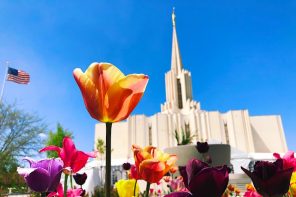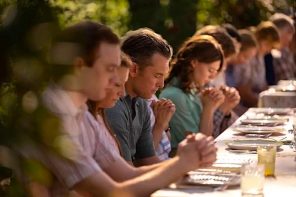If you watch the HBO series Big Love, you know that Barb Henricksen, the first and ranking wife of the Henricksen family, has been moving steadily into the world of Mormon feminism. (Which, by the way, exists in the real world as well.)
Barb’s exploration of her own feminist brand of Mormonism has arguably taken center stage this season. After being excommunicated from the mainstream LDS Church for polygamy, Barb went to Sunstone (which is a real-life magazine and symposia series attracting scholarly and liberal Mormons) to participate in a panel about the pain of excommunication. She’s instructed the Henricksen family that women have a “divine ability to discern the truth for themselves.” She’s offered to give a sister wife a blessing. She’s declined to take the sacrament at Bill’s church, the New Assembly of Mormon Pioneers, whispering a polite “no, thank you.” And she’s consulted with Mormon Studies professor Renee Clayton (played by Judith Ivey) to learn more about Mormon women’s history.
A stunning new article in the peer-reviewed Journal of Mormon History shows that on this much the fictional Renee Clayton and Barb Henricksen are absolutely, non-fictionally right: Mormon women do have a long history of conducting and administering sacred rites both inside Mormon temples and in their own homes and communities.
Historians Jonathan Stapley and Kristine Wright, working from an impressive archive of primary sources, have documented a strong and continuous culture of women’s ritual administration—including anointing with oil and healing by “the laying on of hands”—that persisted from the 1840s into the twentieth century, diminishing only with the growth of the LDS church and twentieth-century efforts by LDS leaders to regulate and standardize institutional church practices.
To summarize: ritual practices that in the contemporary mainstream LDS church are now understood to be the exclusive province of male priesthood holders once belonged also to women.
Just as Bill Henricksen feels he is reaching back into Mormon history to restore polygamous practices abandoned by the institutional LDS Church, Barb’s also doing her part to bring back what she feels are important but abandoned elements of Mormon tradition. The difference? Bill’s reinvigorated, non-mainstream Mormonism remains overtly patriarchal. Barb’s quasi-reconstructionist Mormonism is decidedly feminist. On great historical grounds, grounds that deserve to be better understood by mainstream contemporary Mormons and the fictional Bill Henrickson alike.




